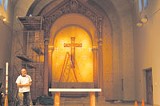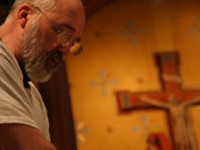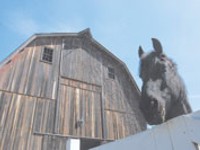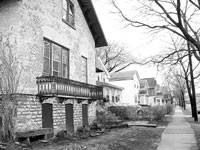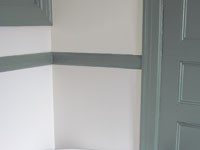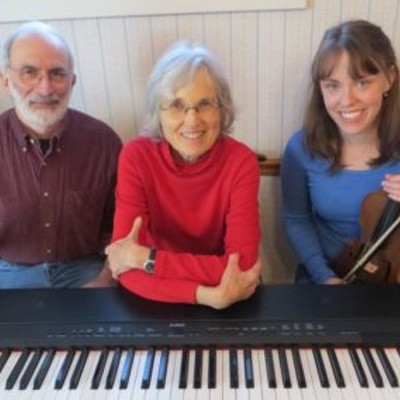[
{
"name": "500x250 Ad",
"insertPoint": "5",
"component": "15667920",
"parentWrapperClass": "",
"requiredCountToDisplay": "1"
}
]
"It's almost like the guy who likes to restore cars," says Henry Swiatek. "You know people who do it because they love doing it, they rebuild an old car. Well, this is me, this is what I like to do."
Swiatek is standing in St. Margaret Mary Church in Irondequoit, his work clothes covered in so many paint colors it looks like a Technicolor dreamcoat. He's gesturing to scaffolding against the east wall, where garnet and gold paint details have already been applied. In the rear of the church, on a work table covered with design plans and brushes, sits a small radio softly playing classical music.
This is a little bigger than a car engine. Swiatek is a restoration artisan. He has been keeping the decorative plaster, painted interiors, and murals in churches throughout Western New York looking beautiful --- and beautifully old. He's an artist without a signature.
"One of the ways of explaining it is that there is a distinction between being the composer and the musician," he says. "You can be a musician, you can play Chopin, you can play Beethoven, but you're not going to compose those pieces. Sometimes people fail to see that line. We do artistic things, but I don't see myself as an artist in that respect."
At St. Margaret Mary, Swiatek has already painted the ceiling between the wooden trusses sky blue and has painted the plaster arches in the sanctuary to look like stone. He is now working on decorating the wall behind the crucifix. Rambusch Company, a design and crafts studio in New York City, developed the concept for the sanctuary's design, turning a plain beige wall into a rich tapestry with gilded accents and vine motif extending from the four corners of the cross.
"It has a lot of symbolic meaning to it," Swiatek says. "All spiritual life is derived from that very moment. And scripturally, too: 'I am the vine, you are the branches.'" He goes on to explain that the church's sanctuary is an echo of the enormous baldacchino, or canopy, at St. Peter's Basilica in Rome. He then explains the thousands-year-old history of that architecture.
He knows all this because he has read "every book I could pick up" on architecture, sacred architecture, and religious decoration. He does most of his work in churches, which he says is both a conscious choice and also where a lot of the need for restoration happens to be.
"I get to do the type of work that I like to do, and I get to do it in the places that I like to work. There is just really a total lack of interest, an almost apathetic, 'Oh, so what, it's getting old, it had its day.' I love Genesee Country Village Museum, but we're preserving Hemlock cabins and we're letting European cathedrals be abandoned. Where's the rationale behind that?"
Swiatek is actually the "son" in his company's name, H. Swiatek & Son. He learned how to treat old plaster and paint the old-fashioned way: He apprenticed with his father. And an appreciation for old church buildings, combined with the knowledge of how to treat them, has become a passion for keeping them beautiful.
"It may be I would have never become aware of it or sensitive if it wasn't for the fact that my dad and I painted and decorated churches. There were so many places we actually did work pro bono just to save things. They would say, 'Oh, no, take that out. How much would it cost? No, no, just take that out.' I knew in my heart it was wrong."
And the business is now incorporating the third generation. Swiatek's daughter Stacey works with him on many jobs, learning as he did, through practice. His youngest son Brett is getting his BFA from Alfred University in May. Swiatek hopes his son will take the company "global." Or at least get a website up.
Swiatek grew up in a Polish neighborhood in Buffalo, and he says it was a combination of a religious family and a European upbringing --- Polish was spoken in the house, Polish food was on the table --- that brought him to an appreciation for European-influenced, cathedral-style churches.
He remembers his childhood church, Corpus Christi, and its copy of the Raffaello Santi painting, Disputation on the Blessed Sacrament. "The painting is life-sized," he says. "There are probably a hundred figures, saints, and popes, and patriarchs. I grew up with all those images in my eyes, and I figured that's how the rest of the world is."
But it wasn't. When Swiatek first started working with his father, there was very little interest in preservation.
"During the '60s and '70s up until the late '80s, everybody was taking everything out because they thought it was irrelevant," he says. "Everything was faster, cleaner, and then you started to develop a brutal minimalism. 'Less is more; elegance is found in simplicity.' Those things are true. But we don't go to Europe to look at off-white walls or 90-degree angles. We go there to see Westminster Abbey; we go there to see Florence; we go there to see Venice."
Now, with a growing interest in the value of old architecture, there are a handful of restoration graduate programs throughout the country. And Swiatek is glad to see more attention paid to the gems he loves. His aesthetics are rooted there.
"In this type of architecture, there's an arch, and then that pulls your eye through another arch, and then into another," he says. "It creates almost a mystery. It's deeper space. It's harder and more time-intensive to produce that. I think religious space should be transcendent space, that when you walk into it, it takes you somewhere else. We're starved for beauty right now. Where is beauty? Where do we find it?"
The work Swiatek is doing at St. Margaret Mary is simple compared to the work he's done at other churches in the city. Think of a well-preserved urban church in the Rochester or Buffalo areas, and chances are Swiatek has had a hand in keeping it looking amazing: St. Michael's, Ss. Peter and Paul, St. Stanislaus, St. Andrews, Our Lady of Perpetual Help. For all the work he's done, and for being an artisan in the true, nearly lost sense of the word, last year the Landmark Society created a Craftsman Award to give him.
He thinks it was won through his work at St. Stanislaus: "That's very baroque, all plastered walls, a lot of fresco work. To really give a background on what I specifically do, that's a better example." But talk to anyone who's struggled to get the funds and find the right craftspeople to restore a poor parish's church --- to each of them, Swiatek is a hero.
Marion Wilmot, for example, at St. Michael's Church on North Clinton Avenue, halts the conversation at the word "renovation." "Wait a minute," she says, "renovating is tearing out; restoring is taking what you have. That's what Henry does." Wilmot is a parishioner and volunteer on the church's buildings and grounds committee, and she estimates it's been five years since the church started to tackle the extensive water damage inside from a leaky roof. Swiatek was called in to restore huge swaths of murals, stenciling, and plaster work.
He taught Wilmot how to refurbish statues so she could work on a Last Supper relief on the altar where the "paint was coming off like potato chips." He and his daughter reapplied faux marbling to the columns in the sanctuary, cut stencils copying what was left from the existing wall designs, repainted, regilded, replastered, and cleaned wall paintings. Nearly every inch of wall in the sanctuary is covered with ornate designs.
Then, when he realized the lighting was too poor to show off details hidden high in the neo-Gothic ceilings, he added light fixtures, too. He's planning to go back to replace a deteriorating cornice after he's made a rubber mold. "He does it willingly," Wilmot says. "He's a real craftsman."
Swiatek says when he walks into a church for a restoration job, he finds the results of what he categorizes as indifference: painted-over murals, crumbling plaster, additions or decorations that don't match the building's style. His job is to make everything look as if it had always been there.
"One of the things I tell people when they first start working is you pretty much have to bury your ego," he says. "If you do it right, they don't even see your work at all. You just really want to mold yourself right into the space, and when you leave it just looks as though it was cleaned. Then you know you've done the right job."
He gives the example of work he did in a secular space: restoration of some panels in the Davis Opera House at the Genesee Country Museum, the replica 19th-century village in Mumford. After six weeks the museum was still trying to decide who could do the least obtrusive job.
"They even wanted the dust on it," Swiatek says. "We did one panel between one window and another. When they came back in, we said to them, 'Well, we've done a panel. But you're going to have to find out which one it is.' When they couldn't find it, that was the convincing point that we knew what we were doing."
Swiatek is a man behind the scenes. He leaves behind happy customers and happy buildings --- but he's not getting famous, and he's not getting rich. So why do it?
"We have no pyramids in America," he says. "We have no Sistine Chapel. But we do have these, we have things of this value. We need to hold on to them because they're not just architecture, they're history, too, because they tell a story of the way things were. How are we ever going to know that if we wipe them all out?"
Neighborhood churches
As city neighborhoods change, so too does the role of urban churches. There are a number of architecturally significant churches in Rochester --- St. Michael's Church on the corner of Clinton Avenue and Clifford Street, Ss. Peter and Paul on West Main Street, and St. Stanislaus on Hudson Avenue are three examples, and all have recently launched restoration efforts --- in neighborhoods that are constantly changing around them.
Their imposing cathedral-style bodies stick out amid boarded-up storefronts and poverty-ridden residential streets. Today, these churches look like they were put down in the wrong place; they're actually monuments to another time. And their existence is not unusual.
"If you were to study American church-building, you could draw almost a direct correlation between waves of immigration and the way churches were built," says Henry Swiatek, church restoration artisan. "They wanted to create a little piece of where they came from."
Swiatek says immigrants in ethnically Irish, German, Italian, and Polish neighborhoods often donated money and labor to build, before anything else, a church. Huge parishes and ethnic pride meant a high concentration of inner-city churches. "If you were to go to any major urban area anywhere in the Northeast," he says, "if you go to the old ethnic neighborhoods you're going to find a lot of inner-city, very significant buildings."
"It used to be when you stood anywhere you could see another steeple," says Marion Wilmot, a parishioner at St. Michael's. The church was built by German immigrants who, in 1890, mortgaged their homes to create the enormous, neo-Gothic church. Now, the neighborhood is predominately Spanish-speaking and poor. The church has adapted: All signs and literature are in English and Spanish; each week there are both Spanish and English masses.
Wilmot, who identifies herself as one of "the Anglos," says the church campus is morphing into something of a community center. The original church, built in 1874, is a meeting hall, where many neighborhood families hold their Quinceaños and other celebrations, and it's home to St. Mike's Clothing Closet. The former rectory now houses an intergenerational daycare center.
While Wilmot acknowledges that attendance is hurt by the neighborhood's reputation, and that "suburbia won't come down here," she says the church itself --- and anyone associated with it --- is safe. "Nobody hurts us," she says. "Nobody bothers us."
Ss. Peter and Paul, a 1911, Lombard-Romanesque church, also built by German-Americans, is another example. Its surrounding neighborhood is now predominately African-American and Hispanic, and also very poor. Craig Murphy, a parishioner, says that attendance has dwindled to a Sunday average of 80 people. He forecasts that the diocese will soon close it and other area churches, combining them all at St. Monica's in the 19th Ward.
"Sometimes the quality of a parish can't be measured on numbers--- not only the beauty of the church, but the fact that it's in an area in need of a positive force," Murphy says. "It's a rough section. We're feeding the poor, we're churching people. Even if they're not Catholic, it's a community connection. It's not this white, suburban, 'I'll drop some money in the basket; I don't want to see the poor people.'"
The building is unbelievable. Walking in from West Main Street --- the church is kept locked except for services, a necessity that bothers Murphy --- is like stepping through a portal into Europe. Paintings by famed Italian artist Gonippo Raggi --- carefully restored by Swiatek --- are set into the altar and dot the entire ribcage of the barrel-vaulted ceiling. Murphy says most of the parish commutes to the city for mass. He drives from Hamlin every Sunday to attend the church he was baptized in, and where his parents and grandparents were married.
The parish has tried to come up with ideas to keep the church open, including a building within a building, where office space is walled off within the church.
"What do you do with a building like this? Who's going to buy it? Who can afford it?" Murphy says. "If you rent it, you still have to maintain it. If you leave it vacant, then it's going to be vandalized. If you push it down it's going to cost hundreds of thousands of dollars. We're hoping that we can kind of keep going in some capacity."
Swiatek remembers a case from his hometown. "In Buffalo, the former Our Mother of Sorrow Church is now a center for learning," he says. "At one time they were thinking of tearing it down. An African-American gentleman said, 'How can they think of tearing down the most beautiful thing we have in our neighborhood?' That's a beautiful concept."
The Landmark Society will hold its 19th Annual Regional Preservation Conference, "Maintaining Hometown Character in the 21st Century," on Saturday, April 30, at Trinity Episcopal Church, Fall Street, Seneca Falls, 8 a.m. to 3:45 p.m. $40. www.landmarksociety.org, 546-7029 ext 10
Henry Swiatek will discuss his restoration work at 2 p.m. Saturday, May 14, at Ss. Peter and Paul Church, 720 West Main Street, as part of a free Landmark Society-sponsored event. Both Ss. Peter and Paul and West Avenue United Methodist Church will be open to tour during the afternoon. Info: www.landmarksociety.org, 546-7029 ext 10.
In This Guide...
Latest in Preservation
More by Erica Curtis
-
What's in the water?
Jun 14, 2006 -

Roses are red
May 3, 2006 -
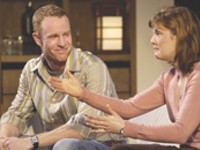
A family in circles
Mar 22, 2006 - More »
